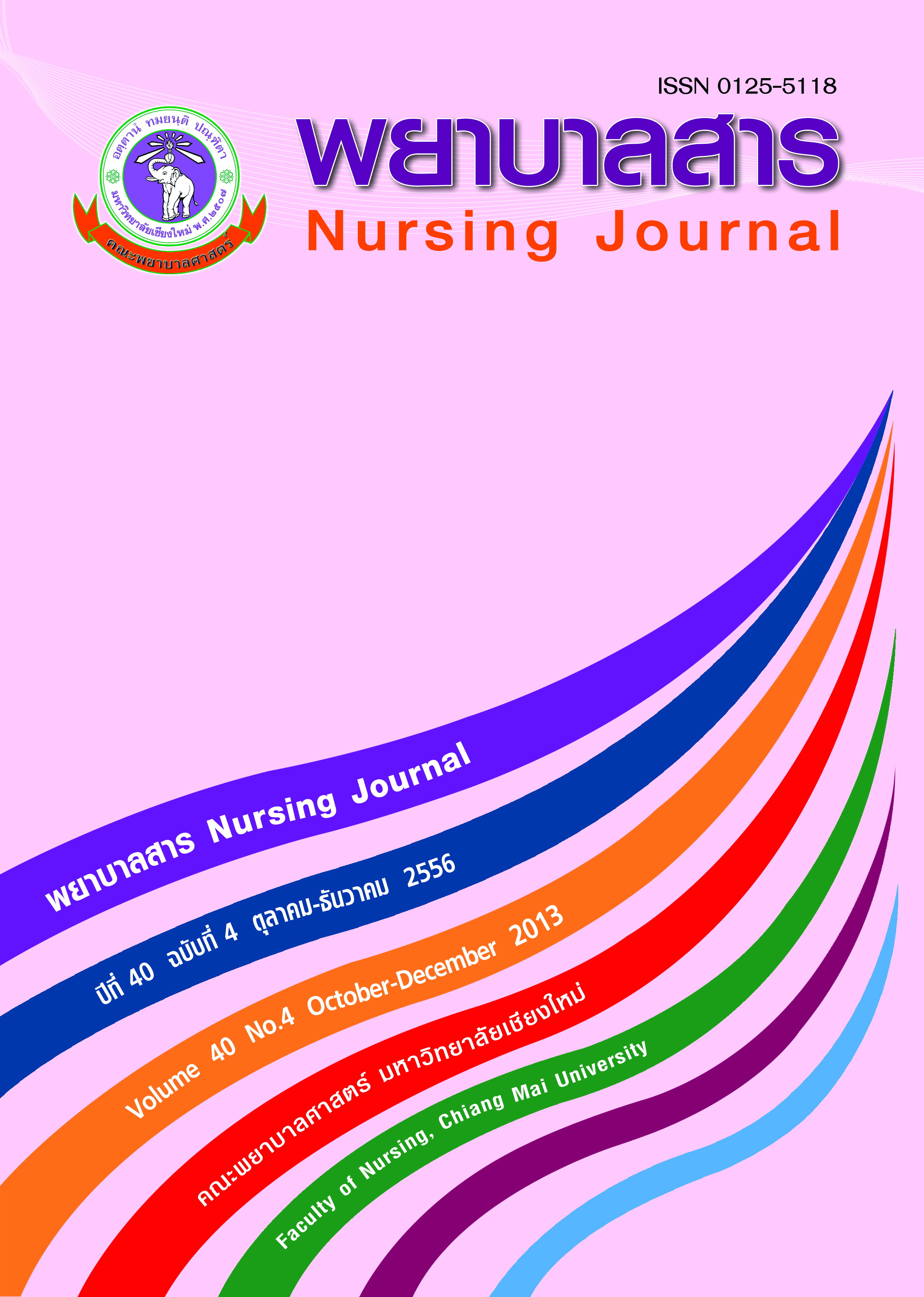ผลของการพัฒนาคุณภาพโดยทีมพยาบาลต่ออัตราการปนเปื้อนเชื้อจุลชีพในเลือดที่ส่งตรวจเพาะเชื้อ
Keywords:
การพัฒนาคุณภาพ, ทีมพยาบาล, การปนเปื้อนเชื้อจุลชีพในเลือดที่ส่งตรวจเพาะเชื้อ, Quality Improvement, Nursing Team, Blood Culture ContaminationAbstract
บทคัดย่อ
การเจาะเลือดส่งตรวจเพาะเชื้ออาจเกิดการปนเปื้อนเชื้อจุลชีพในเลือดที่ส่งตรวจได้ ซึ่งจะมีผลทำให้การวินิจฉัยการติดเชื้อในกระแสเลือดผิดพลาดและผู้ป่วยได้รับการรักษาไม่ถูกต้อง ดังนั้น พยาบาลควรจะมีความรู้และปฏิบัติในการป้องกันการปนเปื้อนเชื้อจุลชีพในเลือดที่ส่งตรวจเพาะเชื้ออย่างถูกต้อง การวิจัยเชิงทดลองแบบสุ่มและมีกลุ่มควบคุมนี้ มีวัตถุประสงค์เพื่อเปรียบเทียบอัตราการปนเปื้อนเชื้อจุลชีพในเลือดที่ส่งตรวจเพาะเชื้อโดยพยาบาลกลุ่มควบคุมที่ทำตามปกติและกลุ่มทดลองที่มีการพัฒนาคุณภาพ การวิจัยนี้ศึกษาในโรงพยาบาลแห่งหนึ่ง ระหว่างเดือนตุลาคม 2554 ถึงเดือนมกราคม 2555 กลุ่มตัวอย่างเป็นพยาบาลจำนวน 55 คน ที่ปฏิบัติงานในหอผู้ป่วยที่ได้จากการสุ่มตัวอย่างแบบง่าย แบ่งเป็น 25 คนในกลุ่มควบคุมและ30 คนในกลุ่มทดลอง ตัวอย่างเลือดที่ส่งตรวจเพาะเชื้อโดยกลุ่มควบคุมและกลุ่มทดลอง จำนวนกลุ่มละ 384 ตัวอย่าง เครื่องมือที่ใช้ในการวิจัย ประกอบด้วยแบบสอบถามข้อมูลทั่วไป แผนพัฒนาคุณภาพโดยทีมพยาบาลซึ่งใช้วงจรพีดีเอสเอ (PDSA) และแบบบันทึกผลการตรวจเพาะเชื้อจากเลือด ซึ่งผ่านการตรวจสอบความตรงเชิงเนื้อหาจากผู้ทรงคุณวุฒิ 5 ท่าน วิเคราะห์ข้อมูลโดยใช้สถิติเชิงพรรณนา สถิติไคสแควร์และอัตราการปนเปื้อนเชื้อ
ผลการวิจัย
พบว่ากลุ่มตัวอย่างมีปัญหาในการเจาะเลือดที่ส่งตรวจเพาะเชื้อหลายประการ ได้แก่ ขาดความรู้และความชำนาญในการเจาะเลือด การเตรียมอุปกรณ์ไม่พร้อมและแสงสว่างในหอผู้ป่วยไม่พอ จึงร่วมกันแก้ไขปัญหาด้วยวงจรพีดีเอสเอ ได้แก่ การจัดอบรมเชิงปฏิบัติการ แจกคู่มือ ติดโปสเตอร์เตือน สนับสนุนชุดอุปกรณ์เจาะเลือดจัดระบบการช่วยเหลือกัน และเพิ่มแสงสว่างในหอผู้ป่วย หลังการพัฒนาคุณภาพพบว่า อัตราการปนเปื้อนเชื้อจุลชีพในเลือดที่ส่งตรวจเพาะเชื้อโดยกลุ่มทดลองลดลงจากร้อยละ 4.7 เป็นร้อยละ 1.0 ซึ่งแตกต่างกันอย่างมีนัยสำคัญทางสถิติที่ระดับ 0.05 โดยที่อัตราการปนเปื้อนเชื้อจุลชีพในกลุ่มทดลองลดลงร้อยละ 78.72 ขณะที่กลุ่มควบคุมลดลงเพียงร้อยละ 9.61การศึกษาครั้งนี้แสดงให้เห็นว่าการพัฒนาคุณภาพโดยทีมพยาบาล ส่งเสริมให้พยาบาลปฏิบัติการเจาะเลือดส่งตรวจเพาะเชื้อได้ถูกต้องเพิ่มขึ้น ส่งผลให้อัตราการปนเปื้อนเชื้อจุลชีพในเลือดที่ส่งตรวจเพาะเชื้อลดลง
คำสำคัญ: การพัฒนาคุณภาพ ทีมพยาบาล การปนเปื้อนเชื้อจุลชีพในเลือดที่ส่งตรวจเพาะเชื้อ
Abstract
Blood culture collection may be contaminated resulting in an incorrect diagnosis causingpatients to receive incorrect treatment; hence, nurses should have the knowledge and experienceto prevent contamination. This randomized controlled trial was aimed at comparing blood culturecontamination rates between the control group who performed routine practice and the experimentalgroup who incorporated quality improvement measures. This study was conducted at a generalhospital during October, 2011 to January, 2012. Subjects were 55 nurses working in patient unitswhich were selected by simple random sampling. Twenty five nurses were in the control group and 30nurses in the experimental group. Blood culture specimens collected by the control and experimentalgroups were 384 specimens in each group. The research instruments consisted of a demographicdata questionnaire, a quality improvement plan by the nursing team using the PDSA’s Cycle, and ablood culture recording form. The content validity was examined by 5 experts. Data was analyzedusing descriptive statistics, chi-square test and contamination rates.
The results of study
Results revealed that the sampled nurses experienced several problems including lack ofknowledge and skill in blood culture collection, insufficient availability of blood collection equipment,and inadequate lighting in patients units. The sampled nurses were aided in addressing theseproblems through workshops, handbooks, posters reminders, proper blood drawing kits, the creationof a peer-to-peer support system, and increased lighting in patient units. After the implementationof quality improvement measures, blood culture contamination rates by the experimental groupsdecreased significantly from 4.7% to 1.0% at the level of 0.05. The rate of blood culture contaminationof the experimental group decreased by 78.72% whereas the rate of the control group decreasedby only 9.61%.The findings of this study indicate that the implementation of quality improvement measuresusing PDSA by nursing teams is effective in improving blood culture collection techniques amongnurses and reducing the blood culture contamination rate.
Key words: Quality Improvement, Nursing Team, Blood Culture Contamination
Downloads
How to Cite
Issue
Section
License
บทความที่ได้รับการตีพิมพ์เป็นลิขสิทธิ์ของวารสารพยาบาลสาร
ข้อความที่ปรากฏในบทความแต่ละเรื่องในวารสารวิชาการเล่มนี้เป็นความคิดเห็นส่วนตัวของผู้เขียนแต่ละท่านไม่เกี่ยวข้องกับมหาวิทยาลัยเชียงใหม่ และคณาจารย์ท่านอื่นๆในมหาวิทยาลัยฯ แต่อย่างใด ความรับผิดชอบองค์ประกอบทั้งหมดของบทความแต่ละเรื่องเป็นของผู้เขียนแต่ละท่าน หากมีความผิดพลาดใด ๆ ผู้เขียนแต่ละท่านจะรับผิดชอบบทความของตนเองแต่ผู้เดียว






